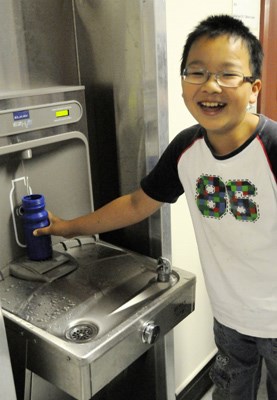On any given day, a line-up of kids forms in the hallway of Ferris elementary, usually just after a gym class or lunch. Shifting from foot to foot, the students patiently wait as they inch forward, each carrying a plastic water bottle.
As his wait comes to an end, one student excitedly holds his bottle under a sensor at the water station and watches as it fills to the brim.
All you have to do is put your bottle there, and the water fountain magically refills the cup, little water is wasted, said Rosy Ren, a Grade 6 student and part of the Green Team. Every time I pass by the station, there are kids filling it up.
The school recently raised $1,500 to have the station installed, which allows students to bring their own re-usable water bottles. Theres also a fountain component for those who forget their bottles or just need a sip.
Its part of a wider movement across Richmond schools to become more water sustainable and to purchase less bottled water. Last year, the project was piloted at every Richmond high school.
If the school raises enough funds to purchase the station, the district pays for the installation, making it a 50/50 split.
Now, some high schools are having their second filling station installed, while elementary schools are beginning to get them as well. Ferris fountain saw its first users in January of this year.
Students love it, they prefer the stations to regular water fountains because the water is chilled, said Tracy Blagdon, manager of energy and sustainability for the Richmond School District. With regular water fountains, the water is a slow drizzle, so these stations are more conducive to water bottles. Water is also not wasted because they arent running water, waiting for it to get cold.
Each station has a counter to calculate every litre of water used. Within a day at Ferris elementary, the counter went from 3,905 to over 4,000, which meant more than 100 students refilled their bottles.
We are now drinking more water than ever, said Jamie Ello in Grade 6 at Ferris. This was an unexpected health component.
Not only has the consumption of water increased, while the use of bottled water decreased, but the use of bottled beverages in general has dipped as well, according to Kevin Lyseng, teacher consultant for environmental stewardship/science at the Richmond School District.
The water is readily available and it doesnt cost them anything, said Lyseng. Its important for the kids to be aware of their waste reduction and its inspiring to see their enthusiasm. When we calculate the 3,905 number at Ferris, we can say thats how many water bottles have not entered the school because of this station.
Ferris, with an enthusiastic Green Team, conducts a variety of environmentally friendly initiatives.
One of their main tasks involves sorting the garbage and sending their refundables to the recycling depot, as a way to fundraise for environmentally oriented field trips.
Even though more students are enrolled this year, the amount of bottles recycled in January of 2012 was 444, while in January of 2013, this number decreased to 298, according to Lyseng.
We realized that even though this would reduce the amount of money we raised, we thought it was for a good cause and good for the environment, said Jayda Santiaguel in Grade 6.
The recycling rate of plastic beverage containers was almost 80 per cent in B.C. in 2011, according to an Encorp Pacific report.
While this is the case, only a little over 50 per cent of the material for each individual bottle is recycled, so waste is still produced, according to Kwantlen University instructor Paul Richard.
Even still, the process of taking the plastic, making a bottle, using the bottle, and recycling the bottle uses up a lot of energy anyway and is damaging in terms of greenhouse gases produced. And thats if theyre getting recycled, which many people do only if its convenient, said Richard, who teaches Enviroment Protection.
Richard estimates the ecological footprint of a reusable water bottle is at least 100 times less than bottled water, if people consume one bottle a day, which is a conservative figure.
We want to help protect the environment for the future, said Eddie Lin, Grade 6. People take it for granted and are focused on now, now, now.
The counts for the water filling stations in Richmond schools reach up to 31,503 at Hugh Boyd secondary (installed in 2011) and 4,086 at Dixon elementary (installed within the past eight weeks), according to data provided by Lyseng.



